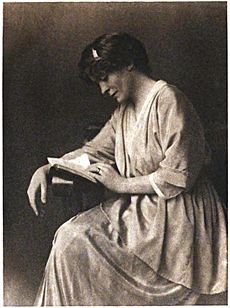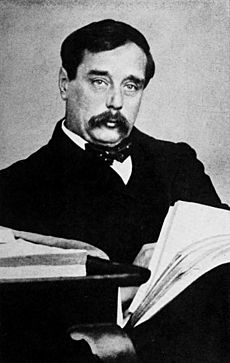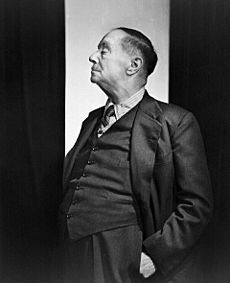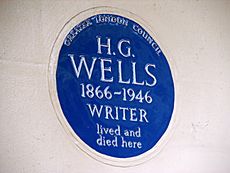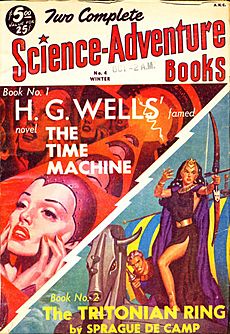H. G. Wells facts for kids
Quick facts for kids
H. G. Wells
|
|
|---|---|
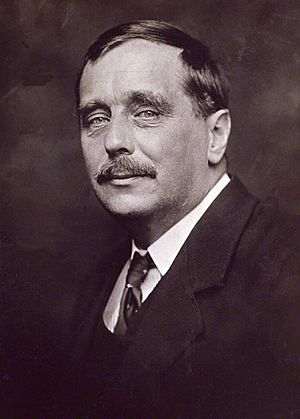
Portrait by George Charles Beresford, 1920
|
|
| Born | Herbert George Wells 21 September 1866 Bromley, Kent, England |
| Died | 13 August 1946 (aged 79) Regent's Park, London, England |
| Occupation |
|
| Alma mater | Royal College of Science (Imperial College London) |
| Genre |
|
| Subject |
|
| Years active | 1895–1946 |
| Notable works |
|
| Spouse |
|
| Children | 4, including George Phillip "G. P." Wells and Anthony West |
| Relatives |
|
| Signature | |
 |
|
| President of PEN International |
|
| In office October 1933 – October 1936 |
|
| Preceded by | John Galsworthy |
| Succeeded by | Jules Romains |
Herbert George Wells (born 21 September 1866 – died 13 August 1946) was a famous English writer. He wrote over fifty novels and many short stories. He also wrote non-fiction books about society, politics, history, and science.
Wells is best known for his amazing science fiction novels. Many people call him the "father of science fiction." He was also known for his ideas about the future. He wrote about things like aircraft, tanks, space travel, nuclear weapons, and even something like the World Wide Web long before they existed.
His science fiction stories explored ideas such as time travel, alien invasion, and invisibility. These topics were not common in books before he wrote about them. A famous writer named Brian Aldiss even called Wells the "Shakespeare of science fiction."
Wells made his stories feel real by adding everyday details. He would then introduce one amazing idea, which became known as "Wells's law." This made his fantastic stories seem believable. His most famous science fiction books include The Time Machine (1895), The Island of Doctor Moreau (1896), The Invisible Man (1897), and The War of the Worlds (1898).
Wells also wrote realistic novels about everyday English life, like Kipps (1905). He was nominated for the Nobel Prize in Literature four times. Wells studied biology when he was younger. He was also a socialist and believed in peace. Later in his life, he wrote more about his political and social ideas. He also helped start a charity for people with diabetes, now called Diabetes UK.
Contents
Life Story
Growing Up
Herbert George Wells was born in Bromley, Kent, England, on 21 September 1866. His family called him "Bertie." He was the fourth and last child of Joseph Wells and Sarah Neal. His father was a former gardener and a professional cricket player. His mother used to be a house servant.
The family owned a shop that sold china and sports items, but it didn't do very well. Joseph Wells earned some money from playing professional cricket for the Kent county team.
When Wells was eight years old in 1874, he broke his leg. While he was recovering, his father brought him books from the local library. He loved reading about other worlds and lives, which made him want to write. He went to a private school until 1880. In 1877, his father broke his thigh, which ended his cricket career. This meant the family had less money.
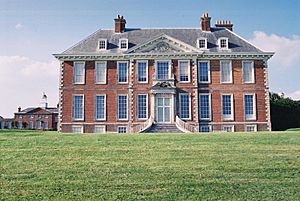
Since they couldn't support themselves easily, the family tried to get their sons apprenticeships. From 1880 to 1883, Wells had a difficult apprenticeship at a drapery store. He worked long hours and slept in a shared room. These experiences later inspired his novels The Wheels of Chance, The History of Mr Polly, and Kipps. These books showed the hard life of an apprentice and criticized how wealth was shared in society.
Wells's parents had a difficult marriage because his mother was a Protestant and his father was a freethinker. His mother later worked as a lady's maid at Uppark, a large country house. She couldn't live with her husband and children there. So, his parents lived separately but remained married. Wells also tried working as a chemist's assistant but didn't succeed.
However, Uppark had a wonderful library. Wells spent a lot of time there, reading classic books like Plato's Republic and Thomas More's Utopia. He also read works by Daniel Defoe. When he became a leading science fiction writer, Wells mentioned Mary Shelley's Frankenstein as a similar type of story to his own.
Becoming a Teacher
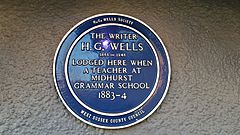
In 1879, Wells's mother arranged for him to become a pupil-teacher at a school in Wookey, Somerset. This meant he was a senior student who also taught younger children. However, he soon returned home. After a short time as a chemist's apprentice and a student at Midhurst Grammar School, he went back to his drapery apprenticeship.
In 1883, Wells convinced his parents to let him leave the apprenticeship. He got another chance to be a pupil-teacher at Midhurst Grammar School. He was remembered for being good at Latin and science. The time he spent in Midhurst helped him continue his self-education.
The next year, Wells won a scholarship to the Normal School of Science in London. This school is now part of Imperial College London. He studied biology there under Thomas Henry Huxley. Wells received a weekly allowance, which should have been enough, but he often felt hungry. Photos from that time show he was very thin.
He joined the school's Debating Society. This is when he became interested in changing society. He first looked at Plato's ideas, then at modern socialism. He also helped start The Science School Journal, a school magazine. This allowed him to share his ideas and try writing fiction. An early version of his novel The Time Machine appeared in this journal. He finished his studies in 1887.
In 1888, Wells lived in Stoke-on-Trent. The industrial area, known as The Potteries, greatly impressed him. He wrote that seeing the iron foundries light up the sky inspired parts of The War of the Worlds. His time there also led to his short story "The Cone" (1895).
After teaching for a while, he worked at Holt Academy in Wales. He also studied educational methods and earned diplomas. In 1890, Wells earned a Bachelor of Science degree in zoology from the University of London. From 1889 to 1890, he taught at Henley House School in London, where A. A. Milne (who wrote Winnie-the-Pooh) was one of his students. His first published book was a Text-Book of Biology in 1893.
After leaving school, Wells didn't have a job. His aunt invited him to stay with her. He started writing short, funny articles for newspapers like The Pall Mall Gazette. He later collected these into books. He wrote so much that many of his early articles are still unknown. His success with these shorter pieces encouraged him to write longer books. He published his first novel, The Time Machine, in 1895.
Family Life

In 1891, Wells married his cousin, Isabel Mary Wells. They separated in 1894 because he fell in love with one of his students, Amy Catherine Robbins. He moved with Amy to Woking, Surrey, in May 1895. They lived in a rented house and married in October 1895.
His time in Woking was very creative. While there, he planned and wrote The War of the Worlds and The Time Machine. He also finished The Island of Doctor Moreau and started other early books.
In 1896, Wells and Amy (who he called Jane) moved to a bigger house. Later, they moved to Sandgate, where he built a large family home called Spade House in 1901. He had two sons with Jane: George Philip (called "Gip") and Frank Richard. Jane died in 1927 at age 55, which greatly saddened Wells.
Wells had relationships with several other women throughout his life. He had a daughter, Anna-Jane, with writer Amber Reeves in 1909. In 1914, he had a son, Anthony West, with writer Rebecca West. He also lived with Dutch writer Odette Keun for a time in France. Later, he became close with Moura Budberg, who cared for him in his final years.
Wells often expressed himself through drawings and sketches. He would draw in his diaries, showing his thoughts on politics, other writers, and his relationships. He called these drawings "picshuas."
Becoming a Famous Writer

Some of Wells's early novels, called "scientific romances," created many themes now common in science fiction. These include The Time Machine, The Island of Doctor Moreau, The Invisible Man, The War of the Worlds, and The First Men in the Moon. He also wrote realistic novels like Kipps and Tono-Bungay, which looked at English culture. Wells wrote many short stories too, like "The Country of the Blind" (1904).
One of Wells's biggest contributions to science fiction was his writing style. He believed that even if a story had impossible elements, the writer should make it seem as real as possible. This helps the reader believe the ideas could actually happen. This is now called "suspension of disbelief." Wells made concepts like invisibility and time travel feel real to his readers. He invented the idea of a "time machine" that lets someone travel through time on purpose. This term is now used everywhere.
He explained that when writing The Time Machine, he realized "the more impossible the story I had to tell, the more ordinary must be the setting." This made the fantastic elements stand out more. His "Wells's Law" states that a science fiction story should only have one extraordinary idea. He used scientific theories to explain these impossible things.
Dr. Griffin, the Invisible Man, is a brilliant scientist who finds a way to become invisible but can't reverse it. He becomes a scary character in horror fiction. In The Island of Doctor Moreau, a man is shipwrecked on an island where a mad scientist turns animals into human-like creatures. This book explores ideas about pain, responsibility, and human identity. In The First Men in the Moon, Wells imagined radio communication between planets, inspired by Nikola Tesla's claims about signals from Mars. Wells also wrote about mythical beings, like an angel in The Wonderful Visit (1895) and a mermaid in The Sea Lady (1902).
Even in his non-science fiction novel Tono-Bungay, radioactive decay plays a small role. It plays a much bigger role in The World Set Free (1914). This book is famous for predicting the atomic bomb. Wells imagined bombs that would explode for days. In 1932, physicist Leó Szilárd, who later helped develop the nuclear chain reaction, read The World Set Free. He said the book made a "very great impression" on him.

Wells also wrote many non-fiction books. His first non-fiction bestseller was Anticipations of the Reaction of Mechanical and Scientific Progress upon Human Life and Thought (1901). This book was subtitled "An Experiment in Prophecy" and showed his ideas about the future. He predicted things like populations moving from cities to suburbs because of trains and cars. He also predicted the defeat of German militarism and the idea of a European Union. However, he didn't expect successful aircraft until after 1950.
His popular two-volume work, The Outline of History (1920), started a new trend in popular world history books. It was very popular and made Wells wealthy. Many other authors then wrote "Outlines" on different subjects. He later wrote a shorter version, A Short History of the World, which Albert Einstein praised. He also wrote The Science of Life (1930) with his son and a biologist, and The Work, Wealth and Happiness of Mankind (1931).
Early in his career, Wells wanted to find better ways to organize society. He wrote several Utopian novels, which describe perfect societies. A Modern Utopia (1905) shows a worldwide utopia. Other utopian stories often start with the world heading for disaster. Then, people realize a better way to live, like a world council of scientists taking over in The Shape of Things to Come (1933). This book accurately showed the coming World War, with cities being destroyed by bombs. He also wrote about the rise of fascist leaders. Wells was seen as a very important writer during this time.
Wells explored ideas about nature and nurture and human identity in books like The First Men in the Moon and The Island of Doctor Moreau. Not all his scientific romances ended happily. When the Sleeper Wakes (1899) is a dystopian novel, showing a future where social classes are very separated, leading to a revolt. The Island of Doctor Moreau is even darker. The main character, after being trapped on an island with animal-human hybrids, returns to England. He finds it hard to see other humans as anything but barely civilized animals.
In 1927, a Canadian writer named Florence Deeks sued Wells. She claimed that parts of The Outline of History were copied from her unpublished manuscript. However, the court found no proof of copying. The similarities were likely because both writers used the same historical sources.
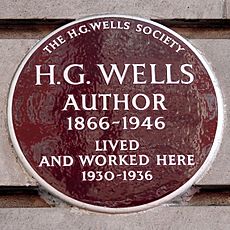
In 1933, Wells predicted in The Shape of Things to Come that a world war would start in January 1940. This prediction came true four months early, in September 1939, with the start of World War II. In 1936, Wells suggested creating a constantly growing "World Encyclopaedia" reviewed by experts and available to everyone. He wrote more about this idea in his 1938 book World Brain.
Before 1933, Wells's books were popular in Germany and Austria. But because he criticized the political situation in Germany, his books were burned by the Nazi youth in 1933. His works were banned. As president of PEN International (an organization for writers), Wells angered the Nazis by removing the German PEN club from the international group. This happened because the German PEN refused to allow non-Aryan writers to join. Near the end of World War II, Allied forces found that the SS had a list of people to arrest if they invaded Britain. Wells was on this list.
Wartime Writings
Wells created rules for playing war games with toy soldiers in his books Floor Games (1911) and Little Wars (1913). He was a pacifist before the First World War. He said these miniature wars were "much better... than the real thing."
In August 1914, after World War I began, Wells published articles that became the book The War That Will End War. He believed the war would make future conflicts impossible. He blamed the Central Powers and argued that defeating German militarism would end all wars. This phrase, "the war to end war," became very common.
In 1918, Wells worked for the British War Propaganda Bureau. He was one of many British authors who signed a statement saying the German invasion of Belgium was a crime. They believed Britain had to join the war.
Trips to Russia
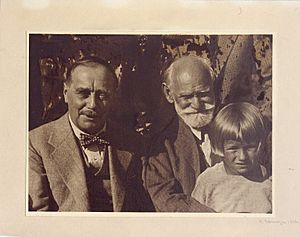
Wells visited Russia three times: in 1914, 1920, and 1934. After his first visit in 1914, he became a "staunch Russophile," meaning he greatly admired Russia. He wrote about his impressions in articles and his novel Joan and Peter (1918).
During his second visit, he met his old friend Maxim Gorky and, with Gorky's help, met Vladimir Lenin. In his book Russia in the Shadows, Wells described Russia recovering from a complete social collapse.
On 23 July 1934, after visiting U.S. President Franklin D. Roosevelt, Wells went to the Soviet Union. He interviewed Joseph Stalin for three hours for New Statesman magazine, which was very rare. He told Stalin he saw "happy faces of healthy people" compared to his previous visit. However, he also criticized the lack of law, class differences, state violence, and no free expression. Stalin enjoyed the talk. Wells hoped to convince Stalin to make reforms, but he realized no changes would happen soon.
Later Life and Death
Most of Wells's best writing happened before World War I. Some younger authors felt he didn't write as well later. George Orwell said Wells was "too sane to understand the modern world."
Wells had diabetes. In 1934, he helped start The Diabetic Association, which is now Diabetes UK.
In 1940, Wells was interviewed on a radio show in Texas. He talked about the sensation caused by Orson Welles's famous 1938 radio adaptation of The War of the Worlds. Wells admitted he was surprised but grateful to Welles for increasing sales of his book.
Wells died on 13 August 1946, at age 79, at his home in London. He once said his epitaph (words on his tombstone) should be: "I told you so. You damned fools." Wells's body was cremated, and his ashes were scattered into the English Channel near Old Harry Rocks.
A blue plaque was placed on his London home in 1966 to honor him.
Wells as a Futurist

Wells was a "visionary" who predicted many future inventions and ideas. He foresaw aircraft, tanks, space travel, nuclear weapons, satellite television, and something like the World Wide Web. Author John Higgs said Wells "saw the coming century clearer than anyone else." He anticipated air wars, cars causing suburbs to grow, and a "world brain" (like Wikipedia).
In his novel The World Set Free, he imagined a powerful "atomic bomb" dropped from planes. This was an amazing idea for a writer in 1913. It greatly impressed Winston Churchill.
In 2011, Wells was featured in a TV series called Prophets of Science Fiction. This show explored how his predictions inspired scientific advancements. In a 2013 review of The Time Machine, Brad Leithauser wrote that Wells was "world literature's Great Extrapolator." He was unique in trying to imagine the far future based on current conditions.
Political Beliefs
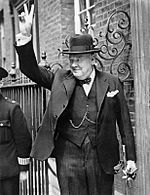
Wells was a socialist and a member of the Fabian Society. Winston Churchill enjoyed reading Wells's books. They stayed in touch from 1902 until Wells died. Churchill even used some of Wells's ideas in his speeches. The phrase "the gathering storm," used by Churchill to describe the rise of Nazi Germany, came from Wells's The War of the Worlds.
Wells wrote a lot about equality and human rights, especially in his book The Rights of Man (1940). His ideas helped create the 1948 Universal Declaration of Human Rights, adopted by the United Nations after his death.
He worked on ideas for the League of Nations, an organization meant to prevent wars. However, he was disappointed when it turned out to be weak and couldn't stop World War II. This made him more pessimistic. In his last book, Mind at the End of Its Tether (1945), he wondered if humanity might be replaced by another species. He called the time between the two World Wars "The Age of Frustration."
Religious Views
Wells's ideas about God and religion changed over his life. Early on, he moved away from Christianity. Later, he moved away from the idea of God, and by the end of his life, he was mostly atheistic.
He said that Christianity was "not now true for me." He felt that if he called himself a Christian, he would be implying too much. He also said that other world religions were "true" in the sense that they existed and served a purpose. But he felt they didn't work for him to live by.
In The Fate of Homo Sapiens (1939), Wells criticized almost all world religions and philosophies. He said there was "no creed, no way of living left in the world at all, that really meets the needs of the time."
Wells's strong opposition to organized religion was clear in his 1943 book Crux Ansata, which criticized the Roman Catholic Church.
His Influence and Legacy
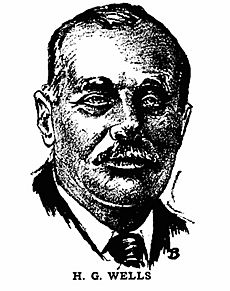
Science fiction historian John Clute called Wells "the most important writer the genre has yet seen." His work has been very important for both British and American science fiction. Author Algis Budrys said Wells "remains the outstanding expositor of both the hope, and the despair, which are embodied in the technology."
Wells was nominated for the Nobel Prize in Literature several times. He influenced space exploration so much that a crater on Mars and one on the Moon were named after him.

In the United Kingdom, Wells's work was a key model for "scientific romance" writers. Authors like Olaf Stapledon and Naomi Mitchison were inspired by him. Wells also greatly influenced British science fiction after World War II. Writers like Arthur C. Clarke and Brian Aldiss admired his work. John Wyndham, known for The Day of the Triffids, shared Wells's interest in disasters.
Wells's early work also made him a hero for dystopian novelist George Orwell. Many modern British science fiction writers, like Stephen Baxter and Christopher Priest, say Wells influenced their writing. He also influenced British scientist J. B. S. Haldane, who wrote about the future of human evolution.
In the United States, Hugo Gernsback reprinted most of Wells's work in his magazine Amazing Stories. He saw Wells's work as central to the new science fiction genre. Later American writers like Ray Bradbury, Isaac Asimov, and Carl Sagan were all influenced by Wells.
Sinclair Lewis's early novels were strongly influenced by Wells's realistic social novels. Lewis even named his first son Wells after the author.
Vladimir Nabokov said Wells was his favorite writer when he was a boy and "a great artist." He praised novels like The Passionate Friends and Ann Veronica. Nabokov said Wells's "romances and fantasies are superb."
Jorge Luis Borges wrote many pieces about Wells, showing he knew Wells's work well. Borges often saw Wells as a very important writer of fantastic stories. He included The Invisible Man and The Time Machine in his list of 100 great works of literature. Canadian author Margaret Atwood read Wells's books. He also inspired European science fiction writers like Karel Čapek.
In 2021, Wells was one of six British writers honored on a series of UK postage stamps. The Time Machine was chosen to represent him.
How Wells Has Been Portrayed
In Books
- The main character in J. D. Beresford's 1911 novel, The Hampdenshire Wonder, was based on Wells.
- In M. P. Shiel's short story "The Primate of the Rose" (1928), a character was written as a parody of Wells.
- In C. S. Lewis's novel That Hideous Strength (1945), the character Jules is a caricature of Wells. Lewis wrote his science fiction partly as a response to Wells's work.
- Wells has a small role in Brian Aldiss's novella The Saliva Tree (1966).
- In Saul Bellow's novel Mr. Sammler's Planet (1970), Wells is one of several historical figures the main character met when he was young.
- Wells is an important character in The Dancers at the End of Time by Michael Moorcock (1976).
- In The Map of Time (2008) by Spanish author Félix J. Palma, Wells is one of several historical characters.
- Wells is one of the two Georges in Paul Levinson's 2013 time-travel story, "Ian, George, and George."
In Movies and TV Shows
- Rod Taylor plays Wells in the 1960 science fiction film The Time Machine. In the movie, Wells uses his time machine to find a perfect society.
- Malcolm McDowell plays Wells in the 1979 science fiction film Time After Time. Wells uses a time machine to chase Jack the Ripper to the present day.
- Wells appears in the 1985 Doctor Who episode Timelash. A young Herbert, who travels with the Doctor, is revealed to be a young H. G. Wells. The story suggests his adventures inspired his novels.
- The character of Wells also appeared in several episodes of Lois & Clark: The New Adventures of Superman (1993–1997).
- In the British TV mini-series The Infinite Worlds of H. G. Wells (2001), Wells himself (played by Tom Ward) is the main character in adaptations of his short stories.
- The high school in the Disney Channel show Phil of the Future is named "H. G. Wells."
- In the 2006 TV show H. G. Wells: War with the World, Wells is played by Michael Sheen.
- An episode of Cold Case (2007) is about a missing housewife during Orson Welles's "War of the Worlds" radio broadcast.
- In the TV series Warehouse 13 (2009–2014), there is a female version of H. G. Wells. She explains that her brother was a front for her writing because a female science fiction author wouldn't be accepted.
- Comedian Paul F. Tompkins plays a fictional Wells as the host of The Dead Authors Podcast.
- A young H. G. Wells appears in the Legends of Tomorrow episode "The Magnificent Eight."
- In The Nightmare Worlds of H. G. Wells (2016), Wells is played by Ray Winstone.
- In the 2017 TV series Time After Time, H. G. Wells is played by Freddie Stroma.
- In the 2019 TV adaptation of The War of the Worlds, the character 'George' shares many traits with Wells.
- Wells is played by Nick Cave in the 2021 film The Electrical Life of Louis Wain.
Movies Based on His Books
Many of H. G. Wells's novels and short stories have been made into movies. These include:
- Island of Lost Souls (1932)
- The Invisible Man (1933)
- Things to Come (1936)
- The Man Who Could Work Miracles (1937)
- The War of the Worlds (1953)
- The Time Machine (1960)
- First Men in the Moon (1964)
- The Island of Dr. Moreau (1996)
- The Time Machine (2002)
- War of the Worlds (2005)
His Writings and Papers
In 1954, the University of Illinois Urbana-Champaign bought H. G. Wells's literary papers and letters. Their Rare Book & Manuscript Library has the largest collection of his writings, letters, and first editions in the United States. This includes unpublished material and the original manuscripts of books like The War of the Worlds and The Time Machine. The collection also has letters from his family, publishers, and famous people like George Bernard Shaw.
Images for kids
-
H. G. Wells on the cover of Time magazine, 20 September 1926.
See also
 In Spanish: H. G. Wells para niños
In Spanish: H. G. Wells para niños




